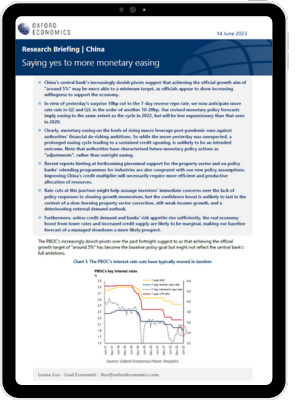China: Saying yes to more monetary easing

China’s central bank’s increasingly dovish pivots suggest that achieving the official growth aim of “around 5%” may be more akin to a minimum target, as officials appear to show increasing willingness to support the economy.
In view of the surprise PBOC cut to the 7-day reverse repo rate, we now anticipate more rate cuts in Q2 and Q3. This will bring total monetary easing to the same extent as the cycle in 2022, but less expansionary than that seen in 2020. A prolonged easing cycle leading to a sustained credit upswing is unlikely to be PBOC’s intended outcome.
What you will learn:
- Recent reports hinting at forthcoming piecemeal support for the property sector and on policy banks’ relending programmes for industries are also congruent with our new policy assumptions. Improving China’s credit multiplier will necessarily require more efficient and productive allocation of resources.
- Rate cuts at this juncture might help assuage investors’ immediate concerns over the lack of policy responses to slowing growth momentum, but the confidence boost is unlikely to last in the context of a slow-burning property sector correction, still-weak income growth, and a deteriorating external demand outlook.
- Furthermore, unless credit demand and banks’ risk appetite rise sufficiently, the real economy boost from lower rates and increased credit supply are likely to be marginal, making our baseline forecast of a managed slowdown a more likely prospect.
Tags:
Related posts

Post
The latest export from China is … deflation
We expect Chinese export price deflation to provide a helpful tailwind in the struggle to bring EM inflation back to target.
Find Out More
Post
Cross Asset: Closing our tactical long on gold, but we’re still bullish
The strength of the recent gold price rally has defied even our already bullish expectations and we think prices are vulnerable to a price consolidation in the short term. As a result, we close out our tactical long position on gold that we opened in October last year.
Find Out More
Post
How Asia’s supply chains are changing | Techonomics Talks
Global supply chains have continued to expand, despite talk of deglobalization and nearshoring. US and Japan have started to de-couple from China, but other G7 countries grow more dependent on Chinese inputs. Several "hotspots" are emerging across Asia with multiple winning formulas.
Find Out More